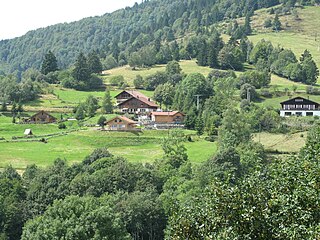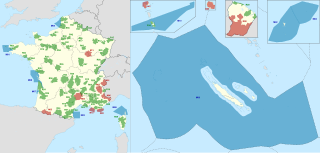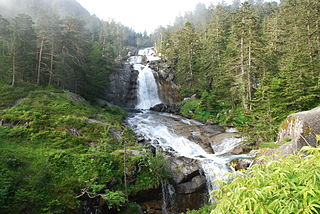
Temperate broadleaf and mixed forest is a temperate climate terrestrial habitat type defined by the World Wide Fund for Nature, with broadleaf tree ecoregions, and with conifer and broadleaf tree mixed coniferous forest ecoregions.

The Vosges are a range of medium mountains in Eastern France, near its border with Germany. Together with the Palatine Forest to the north on the German side of the border, they form a single geomorphological unit and low mountain range of around 8,000 km2 (3,100 sq mi) in area. It runs in a north-northeast direction from the Burgundian Gate to the Börrstadt Basin, and forms the western boundary of the Upper Rhine Plain.

Temperate rainforests are rainforests with coniferous or broadleaf forests that occur in the temperate zone and receive heavy rain.

A regional nature park or regional natural park is a public establishment in France between local authorities and the French national government covering an inhabited rural area of outstanding beauty in order to protect the scenery and heritage as well as set up sustainable economic development in the area.

Haut-Languedoc Regional Nature Park is a regional natural park in the south of the Massif Central within the Aveyron, Hérault, and Tarn departments of France. These areas are considered the Haut-Languedoc, compared to the Bas-Languedoc.

The Sarmatic mixed forests constitute an ecoregion within the temperate broadleaf and mixed forests biome, according to the World Wide Fund for Nature classification. The term comes from the word "Sarmatia".

The Balkan mixed forests are a terrestrial ecoregion of southeastern Europe according to both the WWF and Digital Map of European Ecological Regions by the European Environment Agency. It belongs in the temperate broadleaf and mixed forests biome and the Palearctic realm.

Réunion National Park is a National Park of France located on the island of Réunion, an overseas department in the western Indian Ocean. Established on 5 March 2007, the park protects the endemic ecosystems of Les Hauts, Réunion's mountainous interior, and covers around 42% of the island. Notable endemic species include the Réunion cuckooshrike and the Reunion Island day gecko.

The Italian sclerophyllous and deciduous forests ecoregion, part of the Mediterranean forests, woodlands, and scrub biome, is in Italy. The ecoregion covers most of the Italian Peninsula and includes both evergreen and deciduous forests.

The Dinaric Mountains mixed forests are a terrestrial ecoregion of the temperate broadleaf and mixed forests biome in Southeastern Europe, according to both the WWF and Digital Map of European Ecological Regions by the European Environment Agency. It also is in the Palearctic realm.

The Apennine deciduous montane forests are a temperate broadleaf and mixed forests ecoregion in the Apennine Mountains of Italy. The development of these forests is ensured by the high rainfall in the Apennines, combined with a temperate-cool climate. Because of climate change, the presence of silver fir, although still widespread, has been dramatically reduced in favour of beech.

Poland is part of four terrestrial ecoregions, one freshwater ecoregion, and one marine ecoregion.

Mont Pilat or the Pilat massif is a mountainous area in the east of the Massif Central of France.

Parc Naturel Régional de la Chartreuse is a regional nature park located in the region Rhône-Alpes between Chambéry, Grenoble and Voiron, on the border of the departments of Isère and Savoie. It is based on the massif de la Chartreuse and covers an area of 76,700 hectares with a population of about 50,000. The park was established in 1995.

The Central European mixed forests ecoregion is a temperate hardwood forest covering much of northeastern Europe, from Germany to Russia. The area is only about one-third forested, with pressure from human agriculture leaving the rest in a patchwork of traditional pasture, meadows, wetlands. The ecoregion is in the temperate broadleaf and mixed forest biome, and the Palearctic realm, with a Humid Continental climate. It covers 731,154 km2 (282,300 sq mi).

The Pannonian mixed forests is a temperate broadleaf and mixed forests ecoregion in Europe. It covers an area of 307,720 km2 in all of Hungary, most of Slovakia, about half of Croatia and Slovenia, around a third of Bosnia and Herzegovina, Romania, and Serbia, and minor parts of Austria, Czech Republic, and Ukraine.

The Carpathian montane conifer forests, also known as Carpathian montane forests, is a temperate coniferous forests ecoregion in the Carpathian Mountains of the Czech Republic, Poland, Slovakia, Romania, and Ukraine.

The Pyrenees conifer and mixed forests is a temperate broadleaf and mixed forests ecoregion in southwestern Europe. It extends along the Pyrenees mountains which run east and west along the border between France and Spain, and includes all Andorra. The ecoregion extends from the lower slopes of the Pyrenees to its highest peaks, which include Aneto, Posets, and Vignemale.

The Alps conifer and mixed forests is a temperate coniferous forest ecoregion in central Europe. It extends along the Alps mountains through portions of France, Italy, Switzerland, Germany, Liechtenstein, Austria, and Slovenia. The ecoregion extends from the lower slopes of the Alps to its peaks, which include Mont Blanc, at 4,809 m (15,778 ft) the highest peak in the Alps.

The Southern Annamites montane rain forests ecoregion covers a region of high biodiversity in the central and southern mountains of the Annamite Range in Vietnam. Terrain ranges from wet lowland forest to evergreen hardwood and conifer montane rain forest. There is a short dry season centered on January–February, but fog and dew are common throughout the year and support a lush forest character.








































